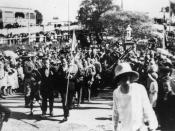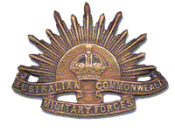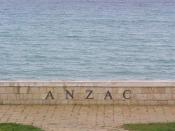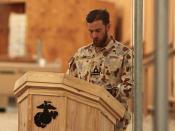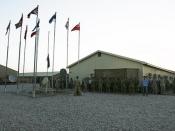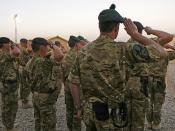Consider How values and characteristics demonstrated by the ANZACs at Gallipoli and later reinforced at the Western Front, continue to influence Australians today.
"With their hair a little whiter, their step not quite so sureStill they march on proudly as they did the year before.
Theirs were the hands that saved us, their courage showed the wayTheir lives they laid down for us, that we may live today."- A Tribute to ANZAC Day by Ken BunkerThere is a day that venerates the events on the 25th April 1915. It is a reminder of the courage and hardships. It is a reminder of the heroic people that created a legend. That legend is the ANZAC legend, that day is ANZAC day and those selfless people are the ANZACs. These soldiers' values and characteristics continue to influence us today. The characteristics of mateship, bravery, resourcefulness and determination that were demonstrated by the ANZACs at Gallipoli and reinforced on the Western Front should inspire us to achieve all that we can.
On the 25th of April 1915, the ANZACs comprised of its 1st Australian Division and the New Zealand and Australian Division, landed at Gallipoli. The landing at Gallipoli turned out, in fact, to be the wrong location. The ANZACs found themselves facing steep cliffs with a continuous volley of sniper fire and shelling. Facing almost impossible odds, the Australian and New Zealand soldiers' determination did not falter. An important fact is that the Australian and New Zealand divisions were entirely a volunteer army. These were ordinary, run of the mill men, with most having little or no military background. Yet they showed courage, determination and resourcefulness in the face of defeat. They created a legend that is still alive today.
Mateship is seen as an Australian icon. In World War One, the Australians were seen as the embodiment of mateship through the works of war correspondents such as C.E.W Bean. However it wasn't all just glorified out of nothing. For the Anzacs mateship had a true meaning, to pick up your mate when he fell. Jack Simpson Kirkpatrick, a field ambulance stretcher bearer, was recommended for a Victoria Cross for his efforts in the war. He would help move the injured with his donkey against constant enemy fire. In twenty-four days he amazingly managed to rescue over three hundred men down the infamous Monash Valley. Simpson's actions are a good example of mateship; he risked his life to save fellow ANZACs.
"'What motive sustained them? ... when the dead lay three deep in the rifle-pits under the blue sky and the place was filled with stench and sickness, and reason had almost vanished - what was it then that carried each man on?...It lay in the mettle of the men themselves. To be the sort of man who would give way when his mates were trusting to his firmness." (Dr. C. E. W. Bean, Official History, Volume. 1, p606, 607).
This passage explains that the motive that sustained them, what had made them carry on was mateship. To be a person their fellow soldiers could depend on was the ANZACs' motivation.
Another characteristic of the ANZACs was courage. The ANZACs truly were courageous men. When reaching Gallipoli, these men faced a harsh terrain and shelling. But as soon as they reached the shore they bravely rushed up the slopes. Despite the odds, the ANZACs fought, even when the chances of dying were high they braved on.
The bravery of the Australian and New Zealand troops did not go unrecognised. For their bravery some received Victoria Cross medals. Albert Jacka received a Victoria Cross when he single-handedly prevented several Turks from reaching a communication trench. Another Victoria Cross was presented to Cyril Bassett, who was the only New Zealander to receive a Victoria Cross.
The ANZACs did not win the battle at Gallipoli, but while they fought they showed a great deal of determination. Even when under heavy Turkish fire, the ANZACs slowly made progress. In the battle, the ANZACs persisted right till the bitter moments. Their determination was undeniably outstanding and is a characteristic of theirs that we should use to help us move forward when the times get rough.
In recent years we've had people who show characteristics like courage, mateship and determination. During the Bali bombings in 2002, a former AFL player Jason McCartney helped save two other ladies, while belittling his own injuries. When due for medical attention later on, he gave his place for someone whom he believed to be worse off. Because of worsening burns and other injuries, Jason almost died. Jason was willing to sacrifice himself for the survival and safety of others. His actions are loosely an act of mateship because he risked his life to help save others. His acts are also acts of bravery.
"Enterprise, resourcefulness, fidelity, comradeship and endurance."That was how the ANZACs were described as by C.E.W. Bean. However this can also be used to describe another group of people, the troops who served in East Timor.
On the 12th of September 1999, Australians joined other nations to provide the East Timorese protection and to allow them to rebuild their new nation. These troops were trying to help a country in need and did so. Australian troops have helped in creating peace in many countries and in doing so, keeping the ANZAC spirit.
And let us not forget poor Sophie Delezio who suffered major burns after she was trapped underneath a car that crashed into the Roundhouse Childcare Centre at Fairlight. Her bravery let her endure the pain and let her come fighting back. Then she was hit by another car, sending her into a life or death situation. Again she came fighting back, displaying the courage that was once part of the ANZACs.
The values and characteristics displayed by the ANZACs continue to influence us today. The characteristics of the ANZACs have been visible in recent times but, in my opinion, not to the extent it could be.
"They shall grow not old, as we that are left grow old;Age shall not weary them, nor the years condemn.
At the going down of the sun and in the morningWe will remember them."-Passage from 'For The Fallen' By Laurence Binyon BIBLIOGRAPHYBOOKS: Anderson, M., Conroy, J., Low, A., Keese, I. (2000). Retro Active 2. John Wiley & Sons,Milton.
Andrews, M. (2004). Defending Australia: The Anzac Spirit. Watts, Sydney.
WEBSITESwww.anzacday.org.auwww.anzacs.netwww.anzacsite.gov.auwww.acn.net.auwww.sixtyminutes.ninemsn.com.au/sixtyminutes/stories/2004_10_31/story_1262.aspCD'sEncyclopaedia Britannica 2001 Standard edition CD
